Indian restaurant madras curry is one of the great ones. Madras curry is on every single restaurant menu for a reason. It’s absolutely delicious.
It’s on the hotter end of the scale. A spicy curry. It can even be a really spicy curry. Some restaurants go a little overboard I find. I like blazing hot madras curry. But not everybody does.
So this version isn’t so hot – medium spicy really. That’s the nice thing about cooking it yourself. You control the heat.
Like it blazing hot? Add more kashmiri chili powder or use one the hotter Indian chili powders. Want your kids to eat it? Roll the kashmiri chili back a bit. It’s up to you.
This is how they do it in restaurants
This madras curry is done in the restaurant style. Like you get when you eat out. Pretty much exactly. It’s all about the prep. Cooking it takes 10 minutes.
Restaurants don’t have big pots of curry sitting around hoping somebody will come and order it. They cook to order.
It’s totally different from home style cooking. Homestyle is about low and long braises. Restaurant style is about speed and efficiency. But with lots of flavour.
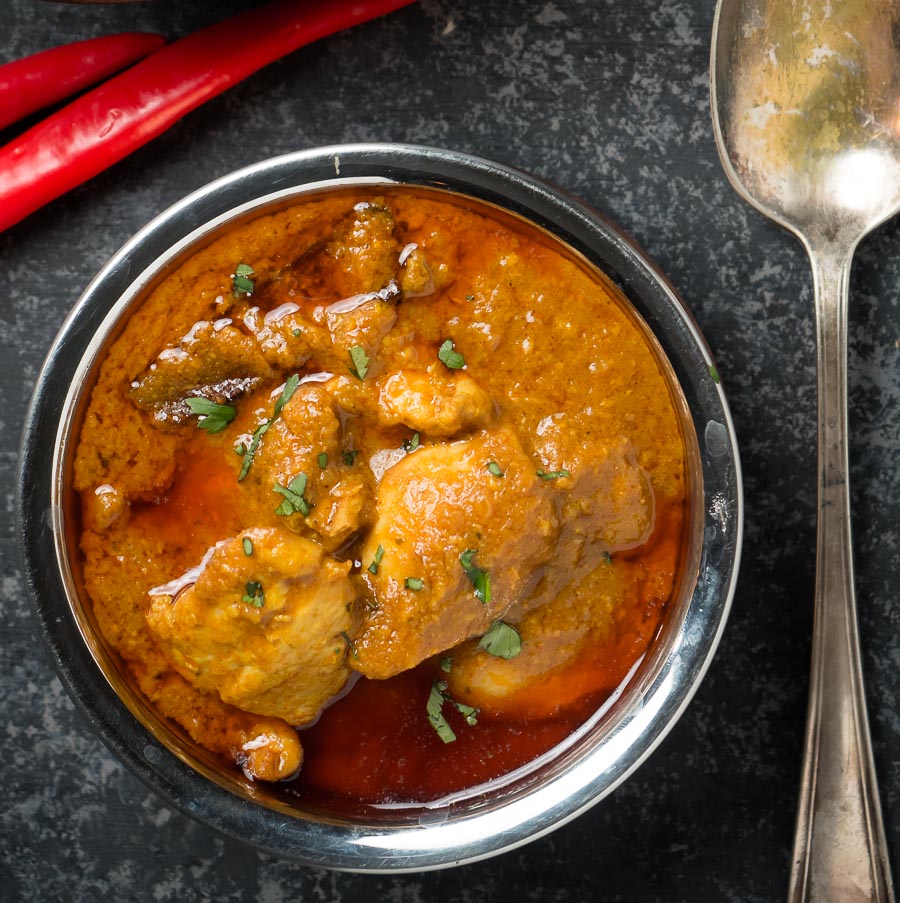
Curry base is the secret
Curry base is a game changer. It’s the way they do it. The foundation of Indian restaurant style cooking. Amazing stuff.
Indian curries generally rely on caramelized onions. That’s what makes them what they are. You need to get that into your dish. And curry base is how restaurants do it. For madras curry. For pretty much all curries.
There’s not much to curry base. It’s basically a whole lot of boiled onions with some flavouring. Tastes like a weak onion curry soup. Bland.
You’d never guess that something so bland can become so good. That’s where the technique comes in.
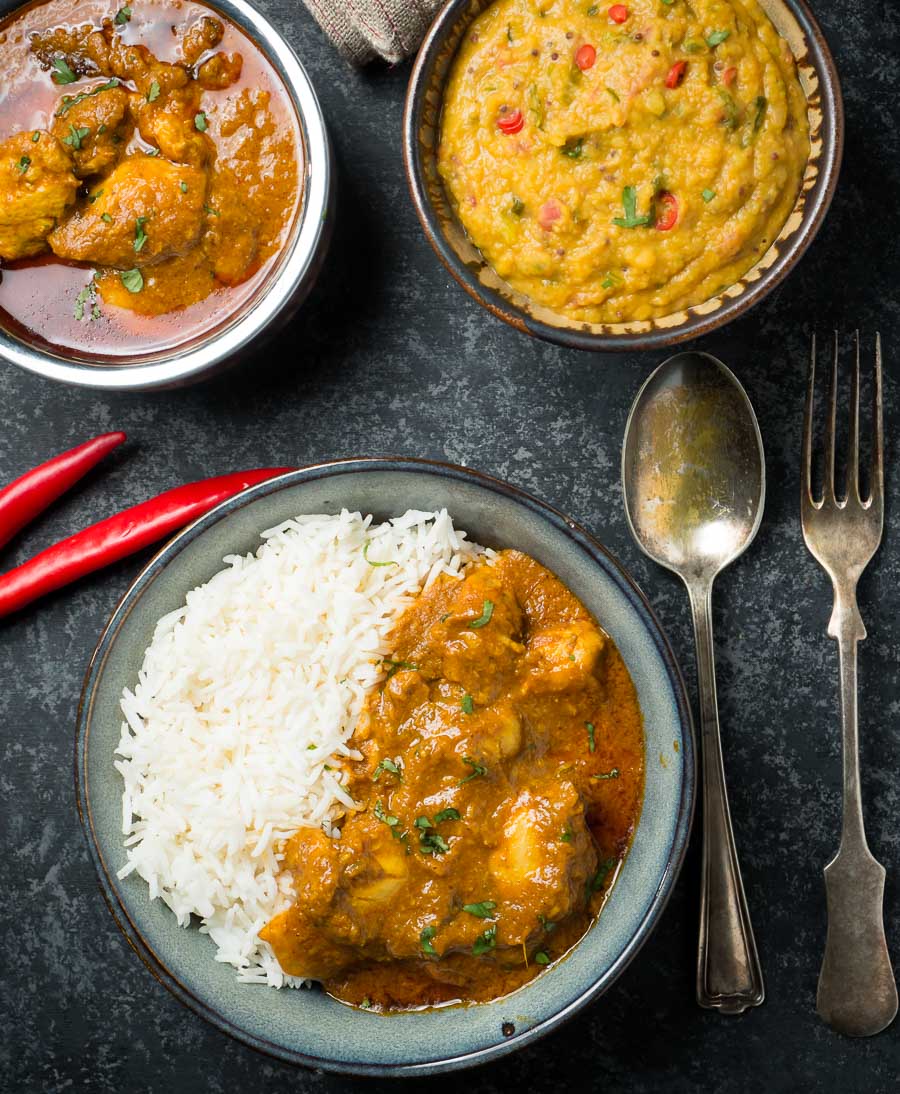
High heat and enough oil makes Indian restaurant madras curry work
The key to making this work is heat. High heat. At the right time. When the curry base hits the pan you want it caramelize. Fast.
It’s a balancing act. The oil can’t be too hot when you bloom the spices. They will burn. Medium heat. Garlic ginger paste goes in next. Tomato after that.
Once you have some wet ingredients in your pan your spices are safe. That’s when you crank it. High heat.
Curry base goes in a bit at a time. You don’t want to cool your pan down too much. Maybe half a ladle at first. Then a full ladle. Then the rest. Somehow it works if you do that.
Read the Indian restaurant curry technique guide
There’s a post that covers the technique and the ingredients you need here. Do yourself a favour. Read it. It will help you understand what you are trying to do.
The recipe below does cover madras curry accurately. If you’ve made a few curries in this style you should have no problem. But if you are just getting started read the guide. It makes things so much easier.
Do your prep before you get started. Make your curry base and have some heated and ready to go. Pre-cook your meat. Measure out your ingredients. Have everything at hand. Put on some old clothes – making restaurant curries is messy stuff.
Watch the video
Chicken madras doesn’t have to be chicken
Almost all the restaurant style curries on glebekitchen can be made how you like. This is a chicken madras. But you can make it with lamb or beef just as easily. You can even make it with chickpeas or masoor dal for a vegetarian option.
Chicken madras is my favourite but lamb is a close second. And a madras curried dal is third. That’s me. You can do what you want. Make this your madras curry. Whatever you want. Just make it.
Madras curry is a spicy dish that’s sure to please. At the top of my list. If you are a fan this is for you. If you haven’t tried it before now is the time.
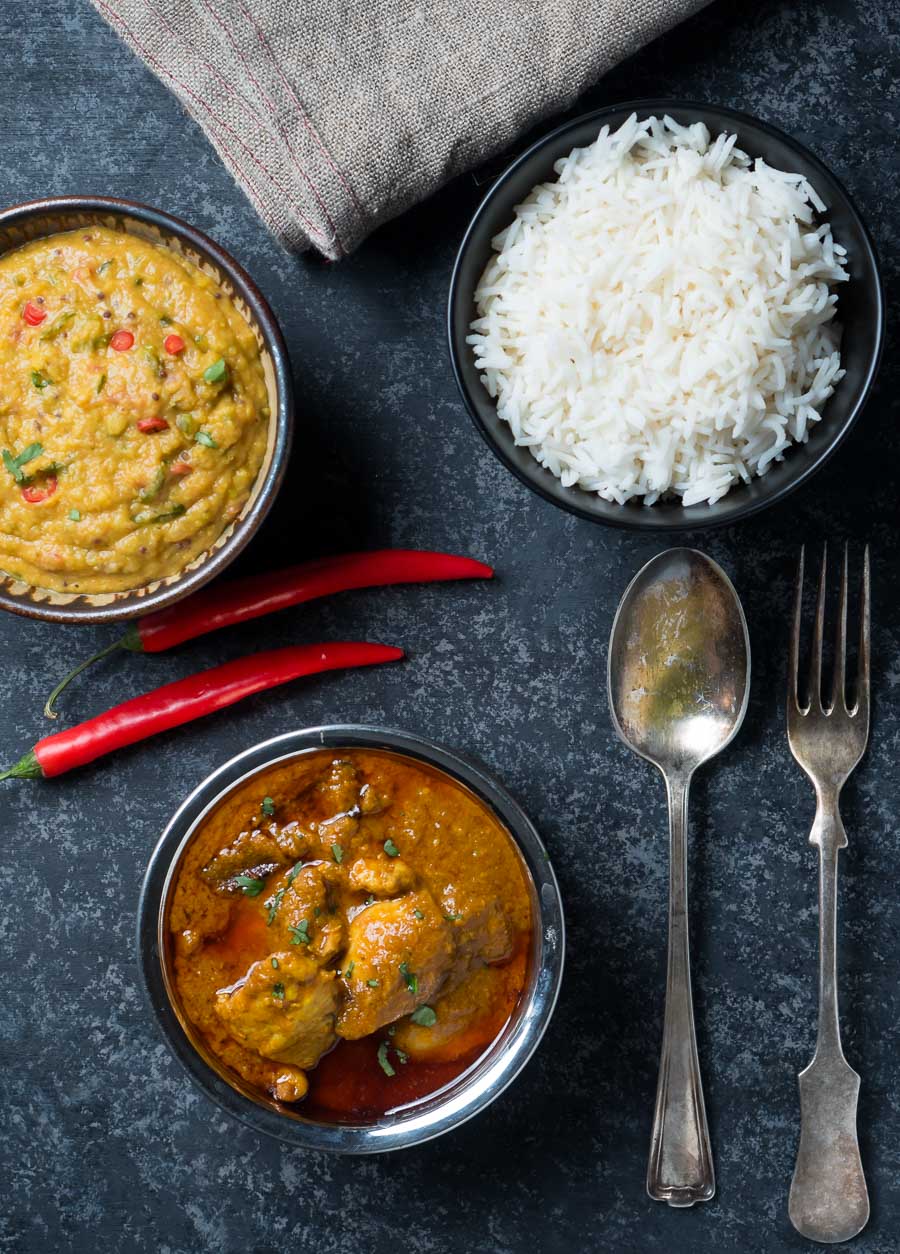
indian restaurant madras curry
Ingredients
The spice mix
- 1 tsp indian restaurant spice mix or curry powder – recipe link below
- 2 tsp hot madras curry powder or use more indian restaurant mix powder if you don’t have any madras curry powder
- 1 tsp kashmiri chili powder or 1/4 tsp cayenne mixed with 3/4 tsp paprika
- 1/2 tsp kasoor methi – dried fenugreek leaves
- 1/2 tsp kosher salt
The curry ingredients
- 4 Tbsp oil
- 2 inch piece of cassia bark or cinnamon stick
- 2 Tbsp onions minced
- 1 Tbsp garlic/ginger paste – recipe link below
- 1 Tbsp tomato paste with enough water to dilute to the consistency of pasatta
- 15 oz curry base – recipe link below
- 10-12 oz pre-cooked chicken or lamb
- 1 Tbsp coconut milk powder in enough water to get to coconut milk consistency (optional)
- 1 tsp fresh lemon juice – about 1/6 of a lemon
Instructions
- Make the spice mix.
- Dilute the tomato paste with enough water to get to the consistency of passata.
- Dilute your coconut milk powder enough with water to get it to the consistency of coconut milk.
- Heat your frying pan (don’t use non-stick) briefly over medium heat. Add the oil.
- When the oil starts to shimmer add the cinnamon stick. Toss is around the pan for about 15 seconds until bubbles start to form around it. It may crackle a bit.
- Add the onions and stir constantly until the edges of the onions start to brown. This takes about a minute.
- Next comes the garlic ginger paste. Add it into the pan and cook it, stirring constantly, until it stops sputtering.
- Turn down the heat and add the spice mix. This is the critical step. Stir it constantly for 30 seconds. If it starts to darken lift the pan off the heat. You want the spice mix to cook in the oil but not burn.
- Turn the heat up to medium high. This is important. The heat is what caramelizes the onion base and gives the curry it’s Indian restaurant flavour. As you become more comfortable with this technique try pushing it. Add the diluted tomato paste and stir until bubbles form (the oil will likely separate). This takes around 30 seconds to one minute depending on the heat.
- Add 3 oz of curry base. Stir until bubbles form (little craters really), around 30 seconds. Think lively boil. Watch the edges of the pan. The curry can stick here. Sticking is OK. Just scrape it back into the base. Burning is bad.
- Now add 6 oz of curry base and stir briefly. Let it cook until the bubbles form again. This takes 1-2 minutes.
- Add the rest of the curry base and let cook until the bubbles form. Add the lemon and diluted coconut milk powder. Turn the heat down to low and add the pre-cooked lamb, beef or chicken.
- Let the curry simmer for about 5 minutes. If it gets too thick add a bit more curry base. Don’t add water.
- Garnish with a bit of chopped fresh cilantro and serve.

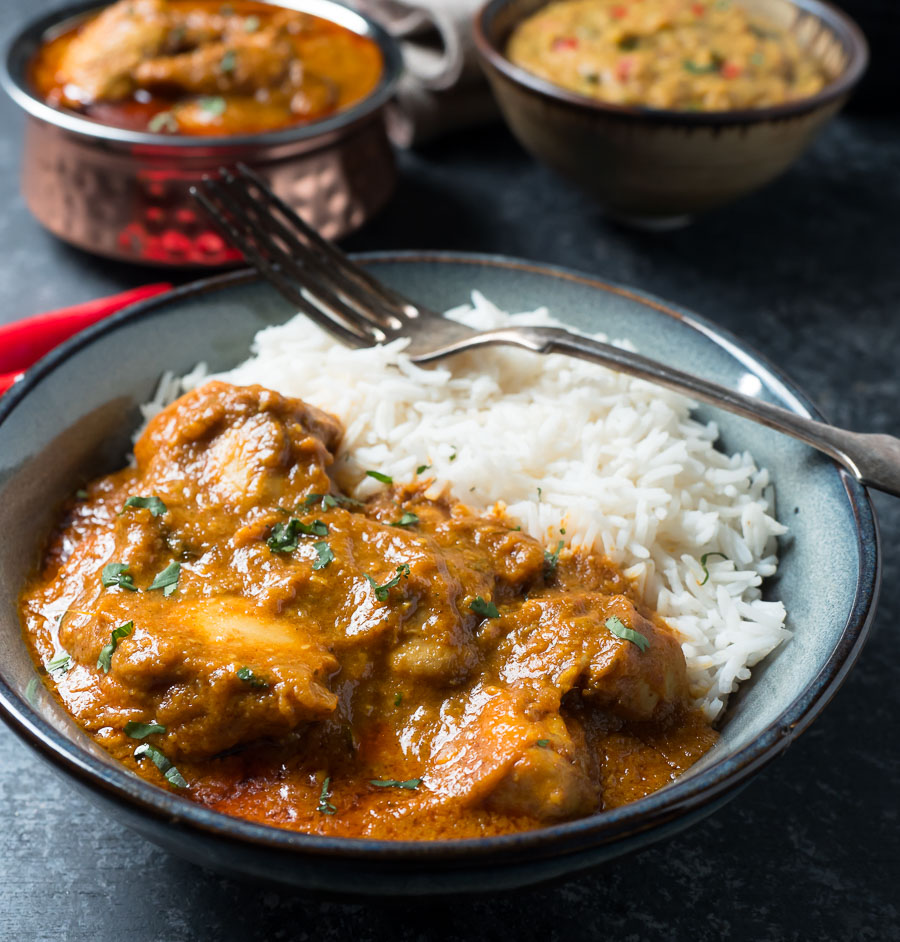
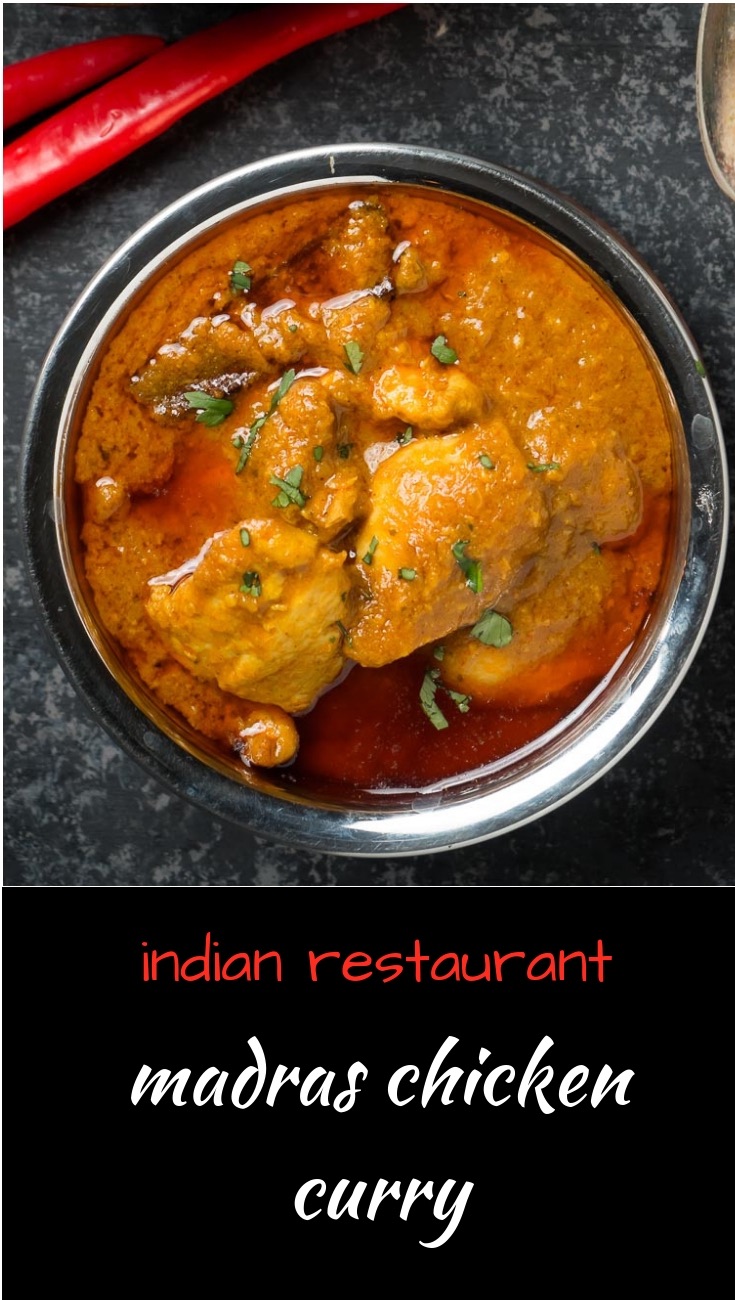

Hi Romain,
I’m making this tomorrow, I’ve made several of your other curries and they’ve all been fantastic. Quick question, as someone that is yet to buy a, how can I put it, non-non-stick pan, is it imperative to use one? I get the bits sticking to the pan is desirable, but does it make a huge difference? I’ve only used non-stick so far as it’s all I have and they’ve turned out delicious, but I’m wondering how much better it actually makes it?
Thanks.
Imperative is a strong word. It is not imperative.
An uncoated or non-non-stick pan makes it a bit harder. I recommend an uncoated pan because I want everyone to succeed and that is easier to do with an uncoated pan. However, if your technique is good, there is enough oil in the pan and you fry your curry base hard you will be fine. At the end of the day, as long as you are happy with what you are cooking, does anything else really matter?
FWIW an uncoated aluminium pan from a restaurant supply store is quite inexpensive if you really want to find out.
Made this last weekend with your nan and Bombay potatoes your recipes beautiful all family loved it thumbs up Thankyou.
Awesome to hear. Delighted everyone enjoyed it. Sounds like you had a feast!
Hi!
Im making this today but want to use tender beef.
I was going to pre cook the beef in my slow cooker (after searing it)
Do you think that will be ok?
Thanks in advance
I’m assuming you are using a cut suitable for stew/braising. If so, yes, however you like to braise beef will work.
Awesome. Thank you so much for your reply.
I also have another ingredient I bought on a whim, that I was considering adding but I don’t want to do so the wrong way. Fresh Red Chillies ‘Ot Hiem’ or ‘Mean Mouth’ chillies, from Vietnam. I’ve seen pictures where madras is garnished with chillies or has slices or fresh chilli inside which made me curious. I do want this curry to be fiery but not inedible.
What stage in cooking, if at all, would you recommend adding these or should i leave it be?
I have no direct experience with ot hiem chilies but google tells me they are around 30,000 Scoville which is not insanely hot (for me). I would taste a bit of one. If you can handle the heat then you should be OK. If you cut them into fairly large pieces you can always eat around them if you run into trouble.
I typically add chilies in with the garlic ginger paste right before adding the powdered spices.
Hi. Could I add a bit of naga pickle at end of this? Have a jar and only have restaurant base gravy left (run out of hotel gravy) Love naga flavour but not sure if it might ruin it. Thanks!
That’s exactly right. Naga is a sledgehammer. It will be tasty I bet but it will be a naga curry if you add more than a pinch.
I have recently begun watching all the great info and videos you post, and am
thrilled to begin my journey into Indian style dishes. But, I found myself watching the indian restaurant curry base post where it said “watch the video here” there was no such video. Also forgive my ignorance, but when you say the curry base is the foundation, I am confused as a few of the recipes do not mention adding the curry base, what am I missing?
I’m not sure where you found the broken link? If you can point me to it I will fix it ASAP!
There are 4 distinct types of curries and associated techniques on glebekitchen.
Traditional or homestyle – There is no curry base involved. This is Indian home cooking
Restaurant style – This is where the curry base gets used. This style will get you curries you would eat in restaurants.
Nearly restaurant style – This is a hybrid approach I came up with. It relies on microwave onions to get you similar results to when you cook restaurant style. It works well. It’s for people who either don’t want to make curry base or are simply out of it.
Hotel style – This is a new approach I’ve been working on. Similar to restaurant style but with more depth of flavour. Think the very best Indian restaurants.
Hope this helps clear things up.
Thank you for getting back to me, I have since figured out my uncertainty and have made the curry gravy base which is excellent. The page where I could not find the video is “Indian Restaurant Curry Base” when you scroll down to “the magic is in the cooking technique” just under there it says you can get a quick lesson on cooking indian restaurant curry here
it takes you to the next page “indian restaurant curry at home and finally when you scroll down it says “this video should help you get started” there is no link. I apologize for the lengthy dialogue, but I hope it helps. Regardless it has been a great awakening for me, thank you for all your expertise and suggestions
Glad you sorted it out. I checked. There is a video at the bottom of that secion that I could see on desktop and mobile. Perhaps it didn’t load correctly for you?
Total game changer finding your recipes on here. I always wondered why my curries didn’t taste like they do when I go out for a meal. Now they are pretty much there. It’s the curry gravy!!!
Can’t wait to try some more of your recipes. My chicken Naga was fantastic! Thanks
Awesome to hear. Always happy when people discover something that makes a difference to them:-)
Romain,
I am compelled to write you a thank you note. I just cooked the best curry I’ve made in over twenty years of trying. I followed your recipe, and also made my own Garlic/Ginger paste for the first time (who knew it was so easy?).
The result looked, smelled and tasted like a restaurant served Madras. You inspired me to get into my local Indian store to hunt out some of the less common ingredients, put in more effort, and get better results.
Another benefit is that now I have the curry base I can create another in under 15 minutes!
I’m grateful for the research you did and your willingness to share it ? Thank you so much!
I am so glad to hear that! Thank you for saying.
Have fun hunting the Indian stores. I’m always in there finding new things.
Hi Romaine, thank you so much for the lovely recipes you have posted on here, so far i have made the bombay aloo, the Palak Paneer and the Tikka masala and the dhansak, I had never ordered it at a restaurant but my boyfriend loved it! He said it was as good as any Dhansak he had before at a curry house! So now i have taken his title of t he house hold curry master, my next mission is Madras. I am servicing the CTM but want to do a beef version of this Madras. Im wanting the meat to be really tender but unsure how to cook this without it affecting the curry when i add it. Any ideas? Many thanks for all the cooking inspo, especially in this covid crisis! 🙂
You are very welcome and I’m delighted you are enjoying the recipes.
For beef I would simply follow your regular stewing technique. I like to braise my beef in a Dutch oven in a 325F oven until tender.
Hi. I’m excited to try this recipe. It looks like you are using shallot at the beginning of the video, though you say onion. Is this the case? With the curry base, what type of onion do you prefer?
I switch between onion and shallot pretty regularly for onions that go into the curry itself. My local Indian grocer stocks the little red Indian onions. If I don’t have those handy I tend to use shallots as a substitute. Failing that I use white onions. For dishes like a jalfrezi or dopiaza where the onion pieces are quite large I usually go with white or red onions as it’s hard to get big pieces otherwise.
For curry base I use a plain brown skinned yellow onion. Nothing fancy there.
Another superb recipe…thank you Romain. I’m going to try a Korma next. If you are reading Glebe Kitchen recipes and drooling over the photos I can attest that it really is possible to make a fantastic curry that looks just like the photos! Thank you again Romain.
I’m super glad you’ve hit your groove! You are very, very welcome:-)
Would love copy of secrets of indian restaurants cookbook
You get it when you subscribe!
Simply excellent! I have been using the enforced idleness of the pandemic to lift my Indian cooking skills and Romain’s recipe’s have been my friend & mentor. I have done 6 or 7 dishes restaurant style and the madras is definitely one of the best (the other family fave is the restaurant Korma). Follow the instructions – especially cranking up the heat when adding the base – and you will have a madras better than you get from most restaurants 🙂
In various iterations I have tried adding some more fenugreek leaves as I love that underlying taste. Also tried adding curry leaves. A few green chillies. A little more kashmiri chilly powder. A little garam masala at the end of cooking. Increasing the cinnamon a bit (I don’t like the taste of cinnamon but it sits underneath the medley of tastes beautifully in this recipe). What absolutely nailed it for me was increasing cinnamon and Kashmiri chilli, adding curry leaves and 2 green chillis. Stunning.
But if you don’t want to play with the tastes, just follow the recipe & you will get a truly exceptional madras! Keep up the great work Romain!
Peter – I absolutely love how you are taking these recipes and making them your own! Your madras is starting to sound a lot like a Ceylon recipe I have on my list to post.
Could you please specify how much water to add to the tomato paste so it’s passata consistency? Thanks!!
I usually go for roughly two to three times the volume of the tomato paste in added water. I have never actually measured the exact amount of water I am afraid.
It isn’t super critical. It’s your safety blanket. You will use it to put the brakes on the spices frying so as long as it’s wet it will do the job. The water will get driven off as you fry the tomato paste before you add the curry base. There’s a lot of evaporation going on in Indian restaurant curry cooking…
just made a restaurant style chicken madras, unbelievable good.
Regards jeff
Awesome!
Have just made a restaurant chicken madras. Absolutely delicious could not believe I’d ever get to make a curry like that at home,
I love when people say that. This is exactly why I run this blog.
Hey Romain, Have been watching your videos and cooking tips on how to cook a madras for a couple of weeks now in an attempt to get organised and ready to cook this for the wife Saturday night. Whilst the wheels almost came off a couple of times the final result was fantastic. Thank You.. However, during the critical stage of frying the spice mix before adding the tomatoes I have at least half of the ingredients in my pan as you did and when I did add the tomatoes again there was still very little in the pan. Although once I started to add the base everything fell into place thankfully!!!! Any ideas WHY !! Oh and I ended up with an unused box of Amchur powder where have I conjured this up from as I don’t see it in your curry base or madras recipes.. Thanks again..
That’s awesome to hear. Yes, the wheels do tend to come off when you are starting out but a bit of practice and you’ll be a master in no time!
Maybe a bit more water in the tomato paste to give yourself a little margin of error? And don’t worry – there are quite a few recipes that use amchoor (spell it like that in the search bar) on the blog and more coming as I love the stuff!
Hey Romain, Decided to try the Chicken Vindaloo recipe as this has always been my wifes favourite. Boy oh Boy am I in the good book now, she loved it, says she hasn’t eaten a curry like that in many a year. Many Thanks. Also got to use up my spare box of Amchoor powder making the chicken Biryani which was very tasty but a little dry. Many Thanks again
Glad she liked it and extra glad I could help get you in the good books:-)